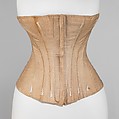Corset
Manufacturer Worcester Skirt Company American
Not on view
In 1950, E.A. Meister, then president of the Royal Worcester Corset Co., donated a collection of 171 corsets to the Brooklyn Museum in memory of Isidor Roth, his father-in-law and former president of the company, who had assembled the collection. The stated dual purpose of the donation was to honor Mr. Roth for his outstanding contributions to the growth of the field of corsetry and to establish a place where the collection could be used as a resource for the history of corsetry.
Overall, the collection of corsets represents prime examples of the stylistic and technological developments which took place from1745-1939. It represents not only the changing silhouette of the past 200 years but also the innovative culture of the corset industry, where solutions to further comfort and increasing flexibility were continually being sought. Known first as The Worcester Skirt Company, the company was founded in 1861 in Worcester, Massachusetts, by David Hale Fanning. It specialized in making hoop skirts to support the full skirts that were in vogue. By March 1, 1872, the company shifted foundation directions, as the focus of the woman's silhouette changed from hoop skirts to shaped torsos and hips, and it was renamed the Worcester Corset Co. Fanning became president when the company went public in 1888. In 1901, the name was changed to the Royal Worcester Corset Co. From waist cinchers to full-length corsets, the collection represents the numerous silhouettes that were in mode, the engineering of the shapers that created them and the measures women took to alter their figures
accordingly.
Documented as being made from the "A la mode" pattern, this corset is one of the earliest examples made by the Worcester Skirt Company during this period. The style of the corset is very short, complimenting the high-waisted fashion that was in vogue. Very plain in its fabrication, this would have been an everyday corset.
Due to rights restrictions, this image cannot be enlarged, viewed at full screen, or downloaded.

